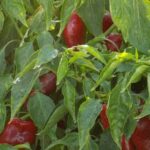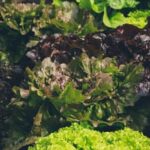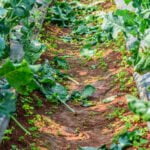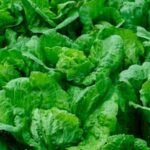Cardboard mulch for vegetable gardens has gained popularity as an eco-friendly and effective gardening practice. Using cardboard as a mulch material offers several benefits, from suppressing weeds to retaining moisture in the soil. Over the years, this technique has become a go-to method for many gardeners looking to improve their vegetable beds.
Cardboard mulch, also known as sheet mulching, involves layering sheets of cardboard over the soil in your vegetable garden. This simple yet impactful method has been used by gardeners for decades and continues to be a sustainable alternative to traditional mulching materials. The benefits of cardboard mulch go beyond weed control and water retention; it also contributes to improving soil health and supporting biodiversity in the garden.
In this article, we will explore the ins and outs of using cardboard mulch in your vegetable garden. From choosing the right type of cardboard and preparing your garden for mulching to planting with cardboard mulch and its impact on the environment, we will provide you with a comprehensive guide to incorporating this unique technique into your gardening practices.
Whether you are a seasoned gardener or just starting out, learning about cardboard mulch for vegetable gardens can help you elevate your gardening game while contributing positively to the environment.
Choosing the Right Cardboard
When it comes to using cardboard mulch for vegetable gardens, it’s important to choose the right type and thickness of cardboard. The most suitable cardboard for mulching is plain, untreated cardboard without any glossy coatings or dyes. This allows for natural decomposition and prevents harmful chemicals from leaching into the soil.
Corrugated cardboard is a popular choice for mulching due to its durability and ability to suppress weeds effectively. It’s important to ensure that the cardboard is thick enough to provide adequate weed control and moisture retention. Typically, cardboard with a thickness of 1/8 inch or more is ideal for use as mulch in vegetable gardens.
Sourcing cardboard for mulching can be done in an environmentally friendly manner by repurposing used boxes from local businesses, grocery stores, or shipping companies. Many of these entities are happy to give away used cardboard for free, making it an affordable and sustainable option for gardeners.
These considerations allow gardeners to make informed choices when selecting cardboard mulch for their vegetable gardens, ensuring optimal results and environmental sustainability.
| Cardboard Type | Thickness |
|---|---|
| Plain, untreated cardboard | 1/8 inch or more |
| Corrugated cardboard | Durable and effective in weed suppression |
Preparing the Garden
Before applying cardboard mulch to your vegetable garden, it is essential to prepare the area properly. Start by removing any existing weeds, rocks, and debris from the soil. This will ensure that the cardboard lays flat on the ground and prevents any unwanted growth underneath. A clean surface also makes it easier for water to penetrate through the mulch and reach the roots of your vegetables.
Weed Control and Soil Preparation
In addition to clearing out debris, it is important to address weed control and soil preparation. Consider using a natural weed control method such as laying down layers of newspaper or organic mulch before applying the cardboard mulch. This will create an additional barrier against weeds while also providing nutrients to the soil as it decomposes. Furthermore, turning over or aerating the soil will help improve its structure and allow for better drainage, promoting healthy root growth for your vegetables.
Proper drainage is crucial when using cardboard mulch in a vegetable garden. To prevent waterlogging, ensure that your garden beds have adequate drainage. If necessary, consider incorporating raised beds or adding organic matter to improve soil structure and drainage capabilities. By addressing these key factors in preparing your garden, you can set a solid foundation for successful vegetable growth with cardboard mulch.
Using Organic Amendments
Incorporating organic amendments into the soil before laying down cardboard mulch can provide essential nutrients for your plants’ growth. Organic matter such as compost, well-rotted manure, or organic fertilizers can be added to enrich the soil, promoting healthy plant development. This step can significantly contribute to creating a thriving environment for your vegetable plants when combined with cardboard mulch application.
Applying the Cardboard Mulch
When it comes to applying cardboard mulch for vegetable gardens, the process is relatively simple but requires attention to detail for best results. To begin, ensure that the area intended for mulching is cleared of any existing vegetation or debris. This will create a clean surface for the cardboard to be laid down and prevent any competing plants from growing through.
Once the area is cleared, it’s important to address weed control and soil preparation. While cardboard mulch acts as a barrier to weeds, it’s still beneficial to remove any existing weeds before laying down the cardboard. Additionally, consider amending the soil with compost or organic matter for added nutrition and moisture retention.
When laying down the cardboard mulch, start by overlapping the edges of each piece to create a seamless barrier. To secure the cardboard in place, consider using heavy rocks or bricks along the edges or an initial layer of soil on top. Some gardeners also choose to use biodegradable staples or pegs designed specifically for securing mulch materials.
In terms of dealing with edges and corners, it’s important to ensure that all areas are covered evenly without gaps where weeds could potentially emerge. Trim excess cardboard if needed and make sure all edges are firmly secured. With these steps in mind, applying cardboard mulch can be a straightforward process that sets the stage for successful vegetable gardening.
By following these guidelines and techniques when applying cardboard mulch in your vegetable garden, you can create a healthy growing environment that promotes both plant growth and weed suppression while also being environmentally friendly.
Planting With Cardboard Mulch
Best Practices for Planting
When it comes to planting with cardboard mulch in vegetable gardens, there are a few best practices to keep in mind. It’s important to cut holes in the cardboard to allow for planting of seedlings or direct sowing of seeds.
Make sure the holes are large enough to accommodate the root system of the plants, and space them out according to the specific requirements of each type of vegetable. Additionally, consider adding a layer of compost or topsoil on top of the cardboard before planting to provide additional nutrients for your crops.
Watering and Fertilizing Considerations
One of the key benefits of using cardboard mulch in vegetable gardens is its ability to retain moisture in the soil. This means that you may need to adjust your watering schedule, as less frequent watering may be required.
However, it’s important to monitor the moisture levels regularly, especially during hot and dry periods. As for fertilizing, consider using organic fertilizers or compost tea to provide necessary nutrients for your plants without disrupting the natural decomposition process of the cardboard mulch.
Intercropping and Companion Planting
Cardboard mulch also provides an excellent opportunity for intercropping and companion planting in vegetable gardens. Utilize the space between your planted vegetables to grow other compatible plants that can benefit each other by deterring pests, attracting beneficial insects, or providing shade and support.
For example, planting aromatic herbs like basil or dill alongside your vegetables can help repel pests naturally while enhancing biodiversity in your garden. Be mindful of spacing and plant compatibility when planning intercropping and companion planting strategies with cardboard mulch.
By following these best practices for planting with cardboard mulch, you can maximize the benefits of this sustainable gardening technique and enjoy healthy yields from your vegetable garden.
Maintenance and Care
Once the cardboard mulch has been applied to your vegetable garden, it is essential to stay on top of its maintenance and care to ensure the health of your plants and the effectiveness of the mulching. Here are some key tips for maintaining and caring for your cardboard mulch in vegetable gardens:
1. Monitoring for decomposition: Keep an eye on how the cardboard mulch is breaking down over time. As it decomposes, it will eventually turn into a rich, organic material that can benefit your soil. Regularly check for signs of decomposition and breakdown, such as softening and darkening of the cardboard.
2. Adding additional mulch: As the cardboard breaks down, you may need to add more mulch to ensure that the soil remains covered. This can help with weed control, moisture retention, and temperature regulation in your garden beds. Consider keeping some extra cardboard on hand so that you can easily replenish the mulch as needed.
3. Dealing with pests and diseases: While cardboard mulch can help deter some pests and weeds, you may still encounter issues in your garden. Keep an eye out for any signs of pests or diseases, and take appropriate measures to address them without disrupting the mulch too much.
By staying proactive with maintenance and care, you can maximize the benefits of using cardboard mulch for vegetable gardens while ensuring a healthy growing environment for your plants.
With proper maintenance and care, using cardboard mulch in your vegetable garden can have a positive impact on both your yields and the environment.
Harvesting and Yields
When it comes to using cardboard mulch for vegetable gardens, there are specific best practices to follow when it comes to planting. The first step is to ensure that the cardboard has been properly laid and secured in place, allowing for adequate spacing for the plants. Once the cardboard is in place, it’s important to consider watering and fertilizing needs, as well as intercropping and companion planting.
When planting in cardboard mulch, it’s essential to water the area thoroughly before planting. This will help the cardboard begin to break down and create a beneficial environment for plant roots. Additionally, consider using organic fertilizers or compost to provide essential nutrients for your vegetables.
Intercropping and companion planting are also great strategies when using cardboard mulch. Intercropping involves planting different crops in close proximity to one another, which can maximize space and yield while reducing pests and diseases. Companion planting pairs plants together that benefit one another, whether through pest control, pollination, or nutrient sharing.
Overall, proper planting techniques with cardboard mulch can lead to healthier and more productive vegetable gardens. By following these best practices, you can ensure a successful harvest with improved yields and minimal maintenance required.
Impact on the Environment
Using cardboard mulch for vegetable gardens can have a significant impact on the environment, providing sustainability and eco-friendly benefits to gardeners. Cardboard is a biodegradable material, meaning it will break down naturally over time without harming the environment. By using cardboard as mulch, gardeners can reduce their reliance on non-biodegradable materials and contribute to sustainable gardening practices.
In addition to being biodegradable, cardboard mulch also helps with weed suppression, moisture retention, and soil temperature regulation, all of which contribute to healthier and more sustainable gardening practices. This eco-friendly approach to mulching reduces the need for harmful chemical herbicides while promoting a more natural and organic way of maintaining vegetable gardens.
The use of cardboard mulch also has long-term environmental benefits for soil health and biodiversity. As the cardboard breaks down, it adds organic matter to the soil, improving its structure and fertility. This encourages beneficial microorganisms and earthworms, leading to a healthier ecosystem within the garden. Overall, the use of cardboard mulch not only benefits vegetable gardens but also has positive implications for the surrounding environment.
| Sustainability Benefits | Eco-Friendly Impact |
|---|---|
| Reduces reliance on non-biodegradable materials | Promotes natural and organic gardening practices |
| Contributes to sustainable gardening | Reduces need for harmful chemical herbicides |
| Adds organic matter to soil | Improves soil structure and fertility |
Conclusion
In conclusion, cardboard mulch for vegetable gardens offers a sustainable and effective solution for controlling weeds, improving soil health, and promoting healthy plant growth. The practice of using cardboard mulch in gardening has been around for decades, with gardeners reaping the benefits of this eco-friendly method. By utilizing the right type and thickness of cardboard, gardeners can easily prepare their garden beds, lay down the mulch, and enjoy the benefits throughout the growing season.
As we look to the future, it is clear that cardboard mulching will continue to be a popular and environmentally friendly option for vegetable gardens. Its long-term impact on soil health and biodiversity is undeniable, making it a great choice for both experienced gardeners and beginners. With proper maintenance and care, including monitoring decomposition and adding additional mulch as needed, gardeners can expect high yields of healthy vegetables throughout the growing season.
In closing, I encourage all readers to consider trying cardboard mulch in their own vegetable gardens. The benefits are numerous – from weed control to improved soil fertility – making it a valuable addition to any gardening routine. Its eco-friendly nature also ensures that we are doing our part in preserving the environment while enjoying bountiful harvests year after year. So why not give cardboard mulch a try? Your vegetable garden will thank you.
Frequently Asked Questions
What Are the Cons of Cardboard in Garden?
The cons of using cardboard in the garden include the fact that it can take a long time to break down, potentially depriving soil of nutrients and oxygen. Additionally, some types of cardboard may contain harmful chemicals or dyes.
Can I Use Cardboard in My Vegetable Garden?
Yes, you can use cardboard in your vegetable garden as a way to suppress weeds and conserve moisture in the soil. Just make sure to choose plain, uncoated cardboard without any glossy or colored prints that may contain toxic substances.
Does Cardboard Prevent Weeds in Vegetable Gardens?
Cardboard is often used as a weed barrier in vegetable gardens because it blocks sunlight and prevents weed growth. It also helps to retain moisture in the soil, which can be beneficial for the vegetables. However, it’s important to weigh the pros and cons before using cardboard extensively in your garden.

If you’re looking to get into vegetable gardening, or are just looking for some tips on how to make your current garden better, then you’ve come to the right place! My name is Ethel and I have been gardening for years. In this blog, I’m going to share with you some of my best tips on how to create a successful vegetable garden.





